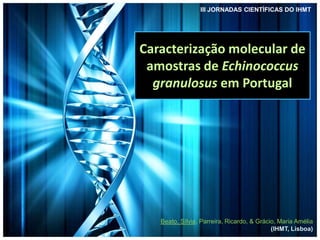IIIjornadasIHMT_SB.pptx
•Transferir como PPTX, PDF•
0 gostou•3 visualizações
Este documento resume um estudo sobre a caracterização molecular de amostras de Echinococcus granulosus em Portugal. O estudo analisou 204 amostras biológicas para identificar os genótipos existentes no país e realizou uma análise filogenética de fragmentos dos genes mitocondriais COI, 12S, 16S, ATP6 e NDI para caracterizar as estirpes genéticas. Os resultados contribuirão para o conhecimento da epidemiologia do quisto hidático em Portugal.
Denunciar
Compartilhar
Denunciar
Compartilhar

Recomendados
Recomendados
Mais conteúdo relacionado
Destaque
Destaque (20)
Product Design Trends in 2024 | Teenage Engineerings

Product Design Trends in 2024 | Teenage Engineerings
How Race, Age and Gender Shape Attitudes Towards Mental Health

How Race, Age and Gender Shape Attitudes Towards Mental Health
AI Trends in Creative Operations 2024 by Artwork Flow.pdf

AI Trends in Creative Operations 2024 by Artwork Flow.pdf
Content Methodology: A Best Practices Report (Webinar)

Content Methodology: A Best Practices Report (Webinar)
How to Prepare For a Successful Job Search for 2024

How to Prepare For a Successful Job Search for 2024
Social Media Marketing Trends 2024 // The Global Indie Insights

Social Media Marketing Trends 2024 // The Global Indie Insights
Trends In Paid Search: Navigating The Digital Landscape In 2024

Trends In Paid Search: Navigating The Digital Landscape In 2024
5 Public speaking tips from TED - Visualized summary

5 Public speaking tips from TED - Visualized summary
Google's Just Not That Into You: Understanding Core Updates & Search Intent

Google's Just Not That Into You: Understanding Core Updates & Search Intent
The six step guide to practical project management

The six step guide to practical project management
Beginners Guide to TikTok for Search - Rachel Pearson - We are Tilt __ Bright...

Beginners Guide to TikTok for Search - Rachel Pearson - We are Tilt __ Bright...
IIIjornadasIHMT_SB.pptx
- 1. Caracterização molecular de amostras de Echinococcus granulosus em Portugal Beato, Sílvia, Parreira, Ricardo, & Grácio, Maria Amélia (IHMT, Lisboa) III JORNADAS CIENTÍFICAS DO IHMT
- 2. Nota Introdutória Quisto Hidático Patologia Molecular Echinococcus granulosus o Helminta (vermes achatados) o Família Taenidae o Disseminação Mundial o Portugal considerado hiperendémico o Variabilidade genética (genótipos - G1 a G10) http://www.bayervet.com.pt
- 3. Genótipo Estirpe G1 Ovelha comum G2 Ovelha da Tasmânia G3 Búfalos G4 Cavalo G5 Bovina G6 Camelo G7 Porco G8 Cervídeos G9 ? Humanos G10 Cervídeos ? Leão Nota Introdutória
- 4. Genótipo Estirpe G1 Ovelha comum G2 Ovelha da Tasmânia G3 Búfalos G4 Cavalo G5 Bovina G6 Camelo G7 Porco G8 Cervídeos G9 ? Humanos G10 Cervídeos ? Leão www.edelkatzen.de/m-wurm.htm (Thompson, R, 2008, Exp Parasit) Nota Introdutória
- 5. 1. Epidemiologia e caracterização das estirpes genéticas de E. granulosus existentes em Portugal; 2. Análise filogenética de fragmentos dos genes mitocondriais e nucleares: - Genes Mitocondriais (COI, 12S,16S,ATP6 e NDI); - Genes Nucleares (em curso) TRABALHO REALIZADO
- 6. METODOLOGIAS Material Biológico: 204 amostras biológicas (ovino, caprino, bovino e humano) – recolha 2009 e 2011 78 amostras férteis (pulmão, fígado e pâncreas) estudo molecular Extracção do DNA:
- 7. Desenho de “primers”: ATP6F: 5’ – AAACTGTRGGGTTCATGTCYC – 3’ ATP6R: 5’ – CACAACATAAAHGGAAAYAAACCAAAC – 3’ 12SrF: 5’ – GGTTTATTTGCCTTTTGCATCATGC – 3’ 12SrR: 5’ – CCTAAGTCAACATCGAGGTGGCAAAC – 3’ 16SrF: 5’ – AGCCAGGTCGGTTCTTATCTATTG – 3’ 16SrR: 5’ – CGAGGGTGACGGGCGGTGTGTAC – 3’ CytBF: 5’ – AGATTGTGGTTYTGTTGARTRCTA – 3’ CytBR: 5’ – ATACACCGAAGAATAGCATAAAAYGC – 3’ (Base nos genomas mitocondriais depositados no NCBI) Amplificação do DNA: - Citocromo c oxidase sub-unidade 1 - Primers: JB 3 (F): 5’ – TTTTTTGGGCATCCTGAGGTTTAT – 3’ JB 4.5 (R): 5’ – TAAAGAAAGAACATAATGAAAATG – 3’ Sequenciação (Bowles & McManus , 1992, Molec. Biochem. Parasitol, 54, 165-174)
- 8. 2. Análise Filogenética • Amplificação de fragmentos do gene COI (Bowles and McManus, 1992). • Amplificação de fragmentos dos genes 12S, 16S e ATP6
- 9. 2. Análise Filogenética (Thompson, R.C., 2008, Exp Parasitol.)
- 10. 2. Análise Filogenética Fragmentos dos genes mitocondriais (COI, 12S, 16S e ATP6) concatenados (~2700 pb)
- 12. AGRADECIMENTOS
Notas do Editor
- - Análise de COI, NDI, ATP6, ITS-1
